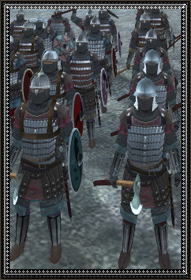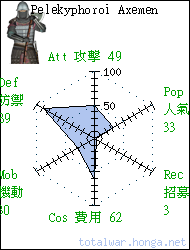|
Pelekyphoroi Axemen
|

Views 查看: 156
|
Class and category 兵種 |
heavy infantry
|
| Soldier 兵員數量 |
ere_elite_varangian_axemen, 30, 0, 1.0
Soldier model, Number of the soldier, Number of extras, Mass of the men
兵種或其乘員, 數量, 附屬單位數量, 衝擊質量
|
| Mount 騎乘座騎 |
Type of animal or vehicle ridden on and its effect
座騎或載具種類及其影響效果
|
| Engine and Ship 攻城器與戰船 |
Siege engine or ship
攻城器具或船隻種類
|
| Attributes 特殊屬性 |
sea_faring, hide_forest, hardy, can_withdraw, frighten_foot
A miscellanious list of attributes and abilities the unit may have
兵種特殊屬性或能力
|
| Formation 陣形 |
2, 2, 2.4, 2.4, 3, square
|
| Hit points 生命值 |
1, 0
Hit points of man, Hit points of mount or attached animal (Ridden horses and camels do not have separate hit points)
生命值, 附屬單位生命值(座騎無額外的生命值)
|
| Primary weapon 主武器 |
21, 5, no, 0, 0, melee, melee_blade, slashing, axe, 25, 1.33, ap
Attack factor, Charging bonus factor, Missile type, Range of missile, Missile ammunition, Weapon type, Tech type, Damage type, Sound type, Min delay between attacks, Skeleton compensation factor in melee, Weapon attributes
攻擊力, 衝鋒加成, 遠程彈藥種類, 射程距離, 彈藥數, 武器類型, 攻擊方式, 傷害類型, 聲響, 攻擊間隔, 動作補償, 武器特殊屬性
|
| Secondary weapon 副武器 |
7, 2, no, 0, 0, melee, melee_blade, slashing, axe, 25, 1, ap
Attack factor, Charging bonus factor, Missile type, Range of missile, Missile ammunition, Weapon type, Tech type, Damage type, Sound type, Min delay between attacks, Skeleton compensation factor in melee, Weapon attributes
攻擊力, 衝鋒加成, 遠程彈藥種類, 射程距離, 彈藥數, 武器類型, 攻擊方式, 傷害類型, 聲響, 攻擊間隔, 動作補償, 武器特殊屬性
|
| Primary armour 主防禦 |
9, 20, 2, metal
Armour factor, Defensive skill, Shield factor, Sound type
護甲防禦值, 格檔技巧, 盾牌, 聲響
|
| Secondary armour 副防禦 |
0, 0, flesh
Animal's or vehicle's armour factor, Defensive skill, Shield factor, Sound type
附屬單位之護甲防禦值, 格擋技巧, 盾牌, 聲響
|
| Heat and ground effect 氣候地形影響 |
0, -2, -3, -2, -1
Extra fatigue suffered by the unit in hot climates, Scrub, Sand, Forest, Snow
炎熱對疲勞度的影響, 灌木叢地形影響, 沙地, 森林, 雪地
|
| Mental 士氣 |
16, disciplined, untrained
Morale, Discipline, Training
士氣, 紀律, 訓練
|
| Cost 招募成本 |
1, 1141, 513, 323, 100, 1141
Number of turns to build, Cost of unit to construct, Cost of upkeep, Cost of upgrading weapons, Cost of upgrading armour, Cost for custom battles, Limit in custom battle, Cost for punish
徵召回合, 招募費, 維持費, 升級武器, 升級盔甲, 自訂戰役, 多於幾隊, 懲罰金額
|
| Unit Description 兵種描述 |
|
|
 |
 As it happened some of the mercenary Varangoi of the Roman Empire went native. Those had children with roman women who in turn joined in the family business of cracking skulls open with a two handed waraxe. Furious in battle and dreadful for tavern owners who were in the way of free drink afterwards, Pelekyphoroi (Native Varangoi) willingly became subjects of the empire, if anything, had a more standardized and slightly better quality of armor. The thickest “bambakion” cotton gambeson available (probably thicker than 1 inch, or even more) would be available to them, with scale or mail “lorikion” of the highest quality, and a reinforced “klibanion” lamellar corcelet. His forearms and lower feet would be protected by arm and leg guard vambraces of splint construction, called “cheiropsella” and “podopsella” respectively. A mail gorget was worn for neck protection. The only Roman units that can compare to them armorwise are Pronoiarioi and Kataphraktoi, (even if they have an extra quilted cloth gambeson “Epilorikion” on top of mail and lamellar) and those have a horse under them to carry all that armor, along with themselves. So it is easy to assume that the Pelekyphoroi must have been at an excellent physical form to be able to not only carry all that armor around, but also fight wearing it. On top of that they had to wield a heavy “Tzikourion” (from the latin root “securis”) or “Pelekys” waraxe, whose metal was a slightly better quality than that of their merc brethren. The round shield they carried, was slung on their back in battle, as the fore arm lamellar guards made the shield redundant in many cases. Pelekyphoroi were Christian, still they carried in their shields the crow which was the emblem of Odin. Their numbers were never great, but that has more to do with the situation of the empire, which became embroiled in non-ending civil wars towards the end, not their worth. A resurging empire, would definitely put higher numbers of Native Varangoi as a recruitment goal. The empire tried to create a Native Varangoi force and actually achieved it. The importance the empire bestowed upon the Pelekyphoroi (Native Varangoi) is evident, if their unbreakable victory record is to be trusted. Only when everyone else fled did they surrender, and then only to save the life of the Emperor, as happened in Manzikert. The Emperors, especially the Komnenoi, if the words of the Emperor Ioannis I Komnenos (as transferred by Niketas Choniates, (a 12th century source) are to be believed. When asked to risk his Varangoi in a dangerous situation, he considered them priceless. Their value he said was higher than all of the jewels of the empire. That in no way meant that the Pelekyphoroi weren’t used in battle, but that there was always the fear of losing them, along with their valuable services. They fought and bled for the Empire, and were acknowledged (along with their Mercenary brethren) to be one of the few regiments of the Roman army who actually fought during the sacking of Konstantinoupolis at 1204. Unfortunately the breach didn’t occur in their sector or there wouldn’t have been one. In battle they would be indistinguishable to their Mercenarry brethren, sharing all their talents and faults. Even so, brought up in the most beautiful of the cities of Christendom, and realizing that a lot of the natives just couldn’t fight to save their lives, does make those Native Varangoi, patriotic in the modern sense of the word, meaning putting their own life on the line for what had become their own country. Their absolute loyalty to the Emperor as well as their love for heavy drinking was legendary. Niketas Choniates in the 12th centrury, describes the personality and character of the Varangoi “Pelekyphoroi” (axe bearers) when he calls them “wine-bags” to emphasize their fondness of alcohol. They must have been impressive to look at, especially from the viewpoint of a Mediterranean subject. Anna Komnene, a contemporary compares them to “tall and strong palm
As it happened some of the mercenary Varangoi of the Roman Empire went native. Those had children with roman women who in turn joined in the family business of cracking skulls open with a two handed waraxe. Furious in battle and dreadful for tavern owners who were in the way of free drink afterwards, Pelekyphoroi (Native Varangoi) willingly became subjects of the empire, if anything, had a more standardized and slightly better quality of armor. The thickest “bambakion” cotton gambeson available (probably thicker than 1 inch, or even more) would be available to them, with scale or mail “lorikion” of the highest quality, and a reinforced “klibanion” lamellar corcelet. His forearms and lower feet would be protected by arm and leg guard vambraces of splint construction, called “cheiropsella” and “podopsella” respectively. A mail gorget was worn for neck protection. The only Roman units that can compare to them armorwise are Pronoiarioi and Kataphraktoi, (even if they have an extra quilted cloth gambeson “Epilorikion” on top of mail and lamellar) and those have a horse under them to carry all that armor, along with themselves. So it is easy to assume that the Pelekyphoroi must have been at an excellent physical form to be able to not only carry all that armor around, but also fight wearing it. On top of that they had to wield a heavy “Tzikourion” (from the latin root “securis”) or “Pelekys” waraxe, whose metal was a slightly better quality than that of their merc brethren. The round shield they carried, was slung on their back in battle, as the fore arm lamellar guards made the shield redundant in many cases. Pelekyphoroi were Christian, still they carried in their shields the crow which was the emblem of Odin. Their numbers were never great, but that has more to do with the situation of the empire, which became embroiled in non-ending civil wars towards the end, not their worth. A resurging empire, would definitely put higher numbers of Native Varangoi as a recruitment goal. The empire tried to create a Native Varangoi force and actually achieved it. The importance the empire bestowed upon the Pelekyphoroi (Native Varangoi) is evident, if their unbreakable victory record is to be trusted. Only when everyone else fled did they surrender, and then only to save the life of the Emperor, as happened in Manzikert. The Emperors, especially the Komnenoi, if the words of the Emperor Ioannis I Komnenos (as transferred by Niketas Choniates, (a 12th century source) are to be believed. When asked to risk his Varangoi in a dangerous situation, he considered them priceless. Their value he said was higher than all of the jewels of the empire. That in no way meant that the Pelekyphoroi weren’t used in battle, but that there was always the fear of losing them, along with their valuable services. They fought and bled for the Empire, and were acknowledged (along with their Mercenary brethren) to be one of the few regiments of the Roman army who actually fought during the sacking of Konstantinoupolis at 1204. Unfortunately the breach didn’t occur in their sector or there wouldn’t have been one. In battle they would be indistinguishable to their Mercenarry brethren, sharing all their talents and faults. Even so, brought up in the most beautiful of the cities of Christendom, and realizing that a lot of the natives just couldn’t fight to save their lives, does make those Native Varangoi, patriotic in the modern sense of the word, meaning putting their own life on the line for what had become their own country. Their absolute loyalty to the Emperor as well as their love for heavy drinking was legendary. Niketas Choniates in the 12th centrury, describes the personality and character of the Varangoi “Pelekyphoroi” (axe bearers) when he calls them “wine-bags” to emphasize their fondness of alcohol. They must have been impressive to look at, especially from the viewpoint of a Mediterranean subject. Anna Komnene, a contemporary compares them to “tall and strong palm
|
|